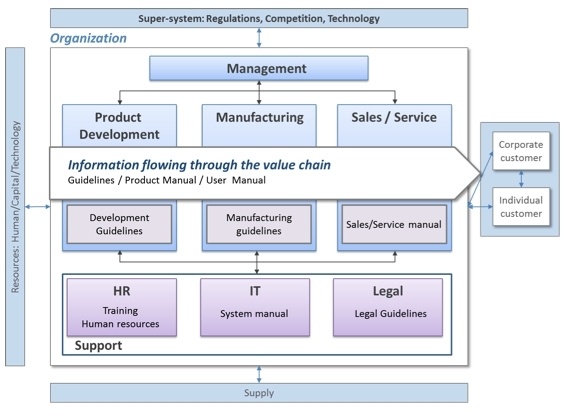The Benefits of Single Source Authoring To Instructional Designers
Among the greatest misconceptions surrounding learning and development organizations is that learning is stuck in the traditional teacher-led classroom using content (textbooks and handouts) and management systems that had their heyday in the 1950s. Or, conversely, all an employee needs is a learning module on a computer screen. Increasingly, informal learning is composing the vast majority of learning opportunities in many organizations. Citing an example from marketing and sales professionals employed at the snack maker Sara Lee, Patti Shank indicated on-the-job experience and networking made up roughly 75 percent of what these individuals deemed most important in terms of workplace training. Meanwhile, formal training programs composed just 8 percent of the overall pie.
We have to face the learning realities in the 21st century – a time when the workforce has shifted toward tech-driven, collaborative paradigms where the workforce is indeed always connected through a variety of devices, but also closely interacting with their colleagues.
Take, for instance, the insightful data points highlighted in "Five Steps to Making Your Content Mobile Ready." The rate at which mobile technology has transformed our everyday behavior - not to mention the way we absorb information - is staggering. Mobile technology, including smartphones and tablets, are part of our lived existence, both socially and professionally.
Why aren't L&D organizations keeping up with this evolution? The way to modernize your L&D organization is through single-source authoring and publishing. The tools certainly exist, but the biggest question mark and obstacle is knowledge.
What's the basis of Single Source Authoring?
For L&D organizations to develop a sustainable and future-proof framework for instructional designers (IDs) to appropriate, they require a learning content management system that fully supports and provides flexibility for authoring and publishing. In other words, they need single source.
Imagine all of your L&D training materials organized in a centralized location. Content authoring, publishing and review are all accessible through a secured Web browser. In doing so, designers have unique opportunities to focus on content instead of spending endless hours working to create materials that are consistent across the board.
How? Each component of an L&D program can be broken down into learning objects that can be manipulated by IDs, depending on the organization's needs. From this point, IDs have the ability to create a library of content that is customizable and reusable. As a result, content is:
- Separate from presentation
- Organized by subject area, competency, job role and many other variables
- Governed by shared output templates when published, giving you consistency and compliance with corporate standards and employee expectations
Using a unified system to author, publish and deliver content, IDs can better analyze how learners access information from the various systems and devices in their learning ecosystem. As a result, the L&D organization learns and responds with greater agility. In the same way marketers use Google Analytics to get insight into customer behavior online, L&D can get granular feedback to see the pathways employees take to satisfy their learning needs. At the same time, social sharing gives the content greater breadth and responsiveness by allowing learners to develop collaborative communities to troubleshoot and grow as they take advantage of performance support and continuous learning.
Why choose a Content Management System for Learning?
Organizations face a multitude of choices, especially when selecting a content management system. Isn't this type of platform sufficient? In the simplest terms, CMSs don't go far enough when you need to apply them in a learning environment. Whether you choose SharePoint or Documentum, these tools fall short. An LCMS is an application specifically designed with instructional designers, subject matter experts and project managers in mind, while also complying with industry standards, such as SCORM, AICC, XAPI, HTML5 and XLIFF.
Many organizations also have an existing LMS. A recent Xyleme blog post distinguishes between an LMS and LCMS, although, they're commonly used in concert. Most modern LMSs are aimed at e-learning, giving learners access to materials and tracking progress through various modules. However, typically you can't create content through an LMS, which limits your ability to leverage user-generated material. Additionally, it's fairly clumsy to track and integrate informal learning using a standard LMS. On the other hand, an LCMS employs single-source authoring and publishing tools that allow for rapid deployment and reuse.
Growing pains: How an energy firm found the answer in single source authoring
Highly regulated industries can benefit from a unified content strategy and a system to manage single-sourced learning content, as one Xyleme customer has shown. This highly celebrated American oil and gas enterprise prioritizes collaboration among its various teams to ensure collective success. Its objective was to provide diverse opportunities for learning that were clearly aligned to the company’s strategic goals and business needs, in the most effective way and as efficiently as possible. However, its enterprise LMS and CMS was holding the company back.
Why? These platforms didn't allow for rapid content development and required excessive resources for development. For instance, 40 percent of the time was spent on formatting, duplication issues and reworking documents.
Accordingly, the company partnered with Xyleme to integrate a state-of-the-art Content Management System for Learning, which provides:
- Accessibility
- Consistency
- Reliability
- Efficiency and productivity
Content can be authored just once and pushed through a multitude of outputs, including PDFs, Word and PowerPoint documents, ePub and responsive HTML. What's more, content can be easily and quickly modified for multiple languages and audiences.
After just 18 months, the time needed to develop a 30 to 40 minute interactive e-learning course fell from 5 to 6 weeks to 3 to 4. The company experienced lower costs to develop, maintain, brand and translate learning objects. Also, it had elevated version control and ability to track development time. In addition, opportunities to reuse content for other modalities and purposes grew significantly once the curriculum managers understood the nature of single-source authoring.
What are the lessons learned?
Single-source authoring is central to the L&D evolution occurring at high-impact businesses. Single source is delivered and sustained through an LCMS. Regardless of your aims - mobile learning, informal learning, e-learning, traditional classrooms - single source creates a framework that gives organizations transparency and agility to develop learning initiatives.
Sources:
- Why Single Source is integral to Blended Learning
- Five Steps To Making Your Content Mobile Ready
- Learning Content Development As a Competitive Advantage, BHG Case Study
- eLearning Guild Research: How Important is Informal Learning?
- LMS vs LCMS









